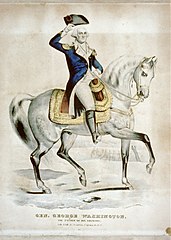
Recently I found myself practicing breathing exercises while my dentist injected numbing medication into my gums. Somehow I had managed to acquire a cavity at the back edge of an existing crown. The crown had to be removed, the cavity treated, and a new crown acquired. And, of course, the afflicted tooth was a the very back of my mouth. Ouch!
Attempting to distract myself, I thought about the characters in my Salem Stories series. Eighteenth century America did not have medication to numb gums, or the ability to save a tooth by creating a crown. So what, I wondered, did Americans do in the 1790s? Was it a case of strong liquor, pliers, and missing teeth?
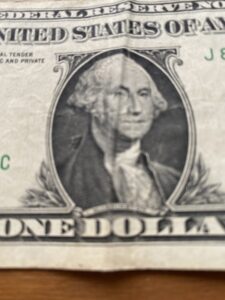
A few days after completing my treatment, my calendar informed me that February 22 was George Washington’s birthday. Washington is famous for many things, among them his false teeth which were not, in fact, made of wood. Gilbert Stuart’s 1796 portrait of Washington on the one dollar bill portrays a man who, in my opinion, clearly did not enjoy moving his mouth. Washington’s stature as commander of the American revolutionary army and the first president of the new United States has made his dental struggles a matter of surprising interest. Washington’s dentures were not unique, but they were well-documented.
The “Gentility” of Straight White Teeth
During the 1720s a group of French practitioners created a profession of dentistry, elevating treatment from simply pulling teeth to one that treated diseases of the teeth and gums, and also created false teeth. As the century progressed, dentists established themselves in North America. False teeth were too expensive for most people, but for George Washington and others of his status, false teeth were important to preserve their social standing.
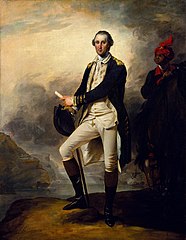
Among genteel social circles, the ideal was clean well-arranged white teeth the color of ivory surrounded by pink gums. Tooth loss was considered an indication of immorality. Tooth decay leading to tooth loss was associated with a lack of personal discipline. The afflicted individual might have lost his teeth due to gluttony, poor dental hygiene, excessive smoking or use of chewing tobacco, or even a case of syphilis. The latter was treated with mercury which caused teeth to decay.
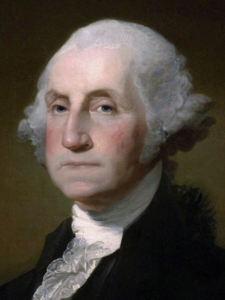
Tooth loss also made eating and speaking difficult, problems false teeth did not solve. Though George Washington wore his dentures through meals and for the toasts following the meals, many sets of false teeth were designed to be removed while eating — discreetly, of course. In President Washington’s case, by the time he became president, he only had one remaining tooth in his head.
Washington’s Dentures
As a young man, Washington suffered from illnesses, including small pox and malaria. Both could be treated with various forms of mercury which could cause excessive salivation, gum inflammation, and loosening teeth.
At the age of 24, Washington recorded that he had paid 5 shillings to a Doctor Watson who removed one of his teeth. Washington kept several of his pulled teeth for use in his dentures. On at least one occasion, according to Washington’s accounts, he purchased teeth from his slaves. At a time when a Dr. Le Mayeur advertised good front teeth for two guineas each, Washington paid one or more slaves 122 shillings for a total of nine teeth.
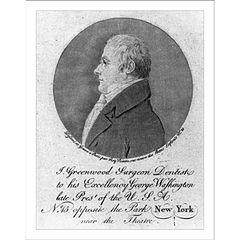
When Washington became president in 1789, Dr. John Greenwood, a New York dentist, created state of the art dentures for the new national leader. The “teeth” were carved out of hippopotamus ivory and used gold wire springs and brass screws that held human teeth. Hippopotamus ivory teeth were heavier than other dental substitutes and required braces on the upper portion to compensate for the weight. They were also expensive.
In 1795 Washington paid Greenwood $60 for a pair of dentures. [$1468.65 in today’s dollars]. In comparison, he paid $25 dollars for a pair of silver-plated candlesticks [$611 today].
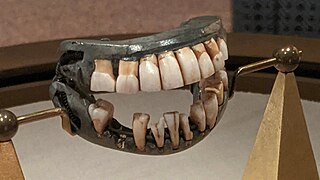
Washington’s first set of dentures used hippopotamus ivory on the base and upper row with eight human teeth on the bottom. The teeth were fastened with gold pivots and secured in the mouth with springs. Hippopotamus ivory is hard and doesn’t yellow with age which makes it a good substitute for teeth, however, the hardness of the teeth makes it very uncomfortable.
In addition to hippopotamus ivory, dentures could also be made elephant ivory, cow and horse teeth, lead tin alloy, copper alloy, silver alloy, and human teeth. Ivory dentures stained easily and needed sealing with wax and chalk.
As it happens, ivory and bone have thin hairline cracks. Washington had a particular fondness for Madeira wine, a dark red liquid. Over time, the wine darkened the teeth; the cracks became darker than the rest of the teeth replacements, and the fine lines made the teeth look wood. Thus, a myth was born.

False teeth were better than no teeth, but they caused pain and facial disfigurement. Washington complained that even Greenwood’s expertly crafted dentures were uncomfortable and made his lips bulge out. They also made speaking difficult which may be why Washington was not a man who indulged in small talk.
There’s nothing like researching 18th century dentistry to make me appreciate the dental care I’ve received over the years. I’m not ecstatic about going to the dentist, but (technically) I do have my own teeth. 😁
If you’re interested in how dentures were made, this video illustrates the process. Clearly, there wasn’t much done to insure a good fit.
🦷 🦷 🦷 🦷 🦷
Illustrations & A Few Sources
George Washington Lithograph; George Washington by John Trumbull, 1780; George Washington by Gilbert Stuart Williamson; Dentist John Greenwood. Larry E. Davis. “Unregulated potions still cause mercury poisoning.” Western Journal of Medicine. 2000 Jul. 173(1):19; Jennifer Van Horn. “George Washington’s Dentures.” Early American Studies. Vol. 14, No. 1. Winter 2016 2-47. Colin Schultz. “George Washington Didn’t Have Wooden Teeth.” Smithsonian Magazine. Nov. 7, 2014. False Teeth. Mount Vernon Library. The Trouble With Teeth. Mount Vernon Library.
Sandra’s Books: Ambition, Arrogance & Pride. Saxon Heroines. Two Coins. Rama’s Labyrinth.

Sandra Wagner-Wright holds the doctoral degree in history and taught women’s and global history at the University of Hawai`i. Sandra travels for her research, most recently to Salem, Massachusetts, the setting of her new Salem Stories series. She also enjoys traveling for new experiences. Recent trips include Antarctica and a river cruise on the Rhine from Amsterdam to Basel.
Sandra particularly likes writing about strong women who make a difference. She lives in Hilo, Hawai`i with her family and writes a blog relating to history, travel, and the idiosyncrasies of life.

